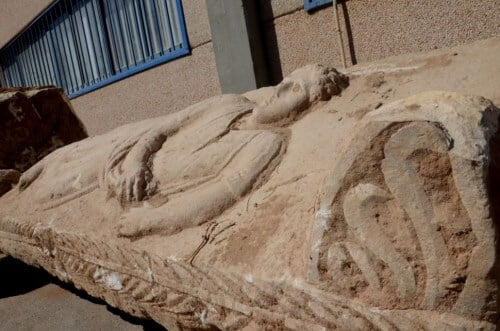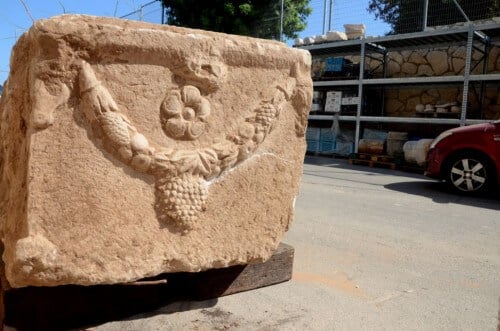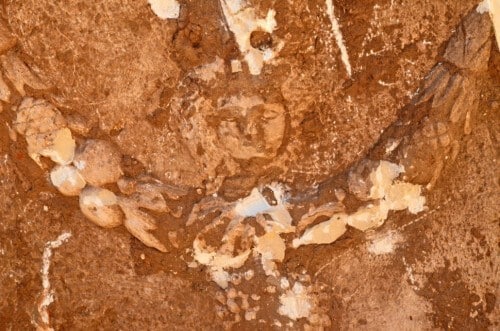The coffin was uncovered during an operational activity by the inspectors of the Antiquities Authority and officers of the Ashkelon Police Station. The coffin, which is one of the most important and beautiful discovered in Israel in the last generation, was severely damaged following its uncontrolled removal from the ground by construction contractors of the city's residents, who hid word of its discovery from the Antiquities Authority. The Antiquities Authority will take legal action against those involved
A very rare and impressive coffin made of stone, about 1800 years old, was uncovered at a construction site in the new villa neighborhood being built in Ashkelon. This, during an operational activity carried out last night (between Tuesday and Wednesday) by the supervisors of the Antiquities Authority's Robbery Prevention Unit, Southern Region of the Antiquities Authority, and the patrol and investigation officers from the Ashkelon Police Station.

This is one of the rarest coffins discovered in the Land of Israel. The coffin is made of hard limestone weighing about 2 tons and 2.5 meters long, and is sculpted on all sides. A full-size human model is sculpted on the lid of the cabinet. The sarcophagus was damaged in various places by a tractor, which left scars in the stone and damaged the hand-sculpted decorations on the sides of the coffin.
The irreversible damage was caused by contractors, who came across the impressive coffin during construction work, decided to hide it, pulled it out of the ground with a tractor while hitting it with a trigger, hid it under a pile of cans and trees, and poured a concrete floor in the lot, with the aim of eliminating evidence of the existence of the antiquities site.

Information received by the Antiquities Authority's Robbery Prevention Unit about illegal activity at the construction site led to a night search of the area. On the spot, five Palestinian construction workers from the Hebron area, ours at the construction site, were detained for questioning. In scanning the field, the sarcophagus and the lid were found which were hidden in the field. During their investigation at the Ashkelon police station, it became clear that the coffin had already been dug up last week. In their investigation, the workers presented the investigators with photos and videos in which the coffin was seen immediately after its discovery, and during the process of removing it from the ground. Later that night, two building contractors who were residents of the city, who were responsible for the construction work on the site, were detained for questioning. The contractors were interrogated with a warning on suspicion of not reporting the discovery of an antiquities and on suspicion of damaging an antiquities site and antiquities - a misdemeanor classified as a crime for which the statutory penalty is 5 years in prison.

Amir Ganor, head of the directorate of supervision at the Antiquities Authority, said that "this is a very serious case of damage to a rare antiquities of unprecedented artistic, historical and cultural importance. The Antiquities Authority is attentive to the needs of development and the needs of the public, but will enforce with a heavy hand against those who violate the faith and damage the antiquities, which are the property of all of us. Out of consideration for the owners of the lots, we allowed construction in the new villa neighborhood, under the condition that they immediately report the discovery of antiquities in the area and stop the work immediately until our representative arrives. In this case, the building contractors chose to hide the rare find, and their actions caused painful damage to history. Legal proceedings will now be taken against those involved, and this will lead to the delay of construction and related financial expenses." According to Ganor, "The right way to conduct business in an ancient and important historical city like Ashkelon is transparency, openness and the landowners walking hand in hand with the Antiquities Authority. Only in this way will the development of the city be possible alongside the protection of public assets, for the common good. The development of the archeology resource in the city of Ashkelon and bringing the public closer to the city is currently a top priority in the work plan of the Antiquities Authority for the coming years."
Dr. Gabi Mazur, a retired Antiquities Authority expert on classical periods, described what appears on the coffin: "On one side of the coffin lid is carved the figure of a man leaning on his left hand. He wears a shirt with short sleeves and decorated with embroidery on the front. A tunic wraps around his waist. The figure's eyes were probably set with gems that have disappeared, and the hair is done in neat curls, in a typical Roman hairstyle. On the other side of the lid is carved in relief a metal amphora (jug used to transport liquids such as wine) from which vine braids carrying bunches of grapes and vine leaves extend. The coffin itself, which was more damaged by the impact of the tractor, is decorated, among other things, with wreaths and figures of bulls' heads, naked cupids, and on top of the monstrous female figure Medusa, whose hair remains entwined with snakes, and this is based on a belief that was accepted in the Roman period, according to which she protects his coffin of the deceased". According to Mazur, such coffins were usually found in or next to family burial structures. The high level of decorations testified to the good economic status of the family, which according to the world of descriptions, was probably not Jewish."

4 תגובות
Liusi: Even in the days of Moshe Dayan, everything was corrupt. And he was not the first nor the last politician in our country who took various benefits for himself in a rash manner and was not prosecuted. Recently, Olmert was acquitted of taking money envelopes even though the judges accepted the matter of the envelopes as fact! There were a few honest politicians - you have to check how many rooms they lived in.
Pretty
If Moshe Dayan kept it with him and sold it to the Israel Museum, what will the wall mosses say?
Then they will ask for protection from one of the leaders of organized crime in the city, and either there will be no trial or they will receive 5 days of forced labor.